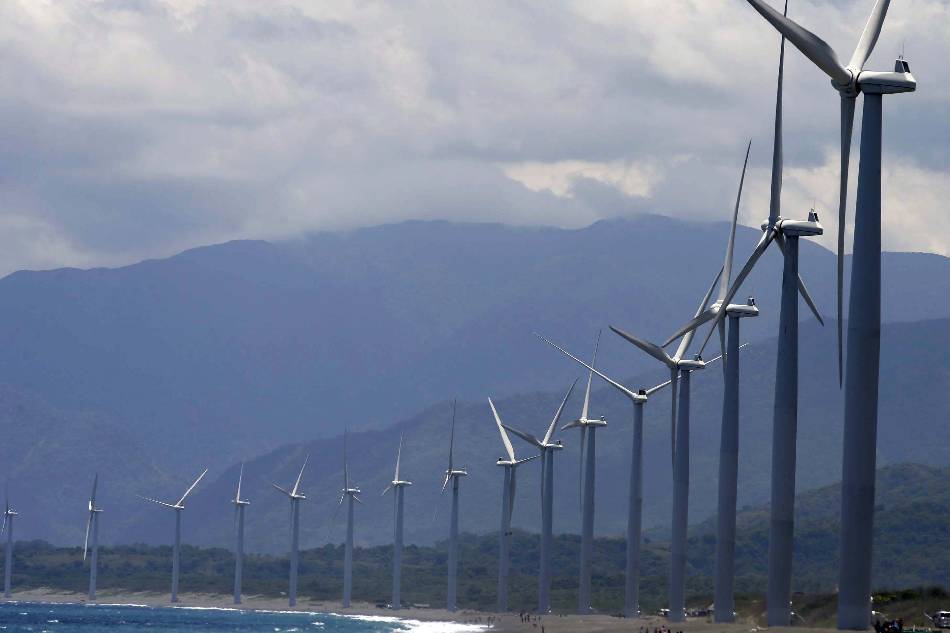Wind, solar now generate record amount of global power | ABS-CBN
ADVERTISEMENT

Welcome, Kapamilya! We use cookies to improve your browsing experience. Continuing to use this site means you agree to our use of cookies. Tell me more!
Wind, solar now generate record amount of global power
Deutsche Welle
Published Apr 13, 2023 11:17 AM PHT
All renewable energy sources made up 39 percent of global electricity last year, according to a report by independent energy think tank Ember.
All renewable energy sources made up 39 percent of global electricity last year, according to a report by independent energy think tank Ember.
The authors predict a phasedown of gas power along with a reduction of coal-fired power, forecasting that fossil fuel generation will decline by 0.3 percent this year.
The authors predict a phasedown of gas power along with a reduction of coal-fired power, forecasting that fossil fuel generation will decline by 0.3 percent this year.
What the report showed
Electricity is as clean as ever, with the share of solar power rising by 24 percent and wind by 17 percent from 2021. Solar and wind energy now makes up over 10 percent of electricity in more than 60 countries.
Electricity is as clean as ever, with the share of solar power rising by 24 percent and wind by 17 percent from 2021. Solar and wind energy now makes up over 10 percent of electricity in more than 60 countries.
Ember's annual global electricity review takes data from 78 countries which account for 93 percent of global power demand.
Ember's annual global electricity review takes data from 78 countries which account for 93 percent of global power demand.
ADVERTISEMENT
The European Union gets 22 percent of its energy from wind and solar power. However, EU countries seem to lag behind global wind energy expansion, with 9 percent of power in the EU coming from wind energy — below the global average.
The European Union gets 22 percent of its energy from wind and solar power. However, EU countries seem to lag behind global wind energy expansion, with 9 percent of power in the EU coming from wind energy — below the global average.
"The EU started the race to renewables early but, as the world accelerates, it cannot afford complacency," said Sarah Brown, Ember's Europe program lead.
"The EU started the race to renewables early but, as the world accelerates, it cannot afford complacency," said Sarah Brown, Ember's Europe program lead.
Russia's invasion of Ukraine in February last year caused concern among EU member states about declining fossil fuel imports. The European Commission put forward a plan to increase renewable energy to 45 percent, an increase of 5 percent compared to the previous year.
Russia's invasion of Ukraine in February last year caused concern among EU member states about declining fossil fuel imports. The European Commission put forward a plan to increase renewable energy to 45 percent, an increase of 5 percent compared to the previous year.
Despite a global gas crisis, the analysis found that gas-fired power declined by 0.2 percent last year due to the high prices making it more unaffordable to use the fuel.
Despite a global gas crisis, the analysis found that gas-fired power declined by 0.2 percent last year due to the high prices making it more unaffordable to use the fuel.
Russia's drastic cut in gas imports has prompted countries such as Germany to restart coal-powered plants and receive liquefied natural gas shipments from abroad. Meanwhile, Germany is pledging to use more renewable sources of energy and has been "a world leader" in the deployment of onshore wind, according to Ember's report.
Russia's drastic cut in gas imports has prompted countries such as Germany to restart coal-powered plants and receive liquefied natural gas shipments from abroad. Meanwhile, Germany is pledging to use more renewable sources of energy and has been "a world leader" in the deployment of onshore wind, according to Ember's report.
In the last five years, however, Germany has installed only a third of the capacity for wind power it added annually in the four years before that. The main causes are not having enough available land for construction, slow licensing procedures, and investor uncertainty.
In the last five years, however, Germany has installed only a third of the capacity for wind power it added annually in the four years before that. The main causes are not having enough available land for construction, slow licensing procedures, and investor uncertainty.
Ember's Sarah Brown said that "the barriers preventing the rapid deployment of onshore wind power must be removed" to reach the EU's targets by 2030.
Ember's Sarah Brown said that "the barriers preventing the rapid deployment of onshore wind power must be removed" to reach the EU's targets by 2030.
RELATED NEWS
ADVERTISEMENT
ADVERTISEMENT



